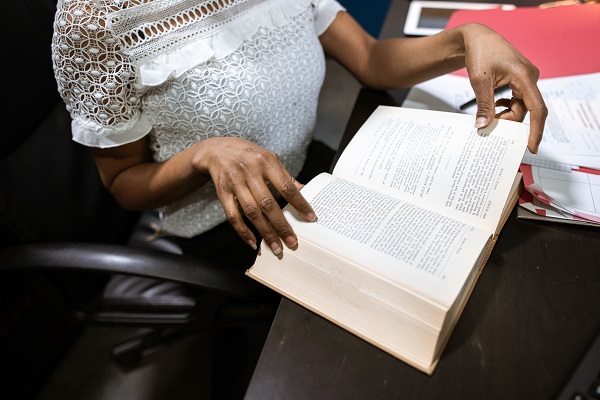There are many tools a writer can use to describe or sell their story. Chief among them are three things: a synopsis, a pitch, and a blurb. In all likelihood, authors will end up writing at least one of each throughout their publishing journey for a book.
For many writers, knowing which to write for any given scenario can be tricky. Writers aren’t given a guidebook on the perfect publishing journey, so writing promotional content like synopses, pitches, and blurbs can be hard.
What is a pitch, really? What does ‘blurb’ mean? How do I write a synopsis? These are all questions plenty of authors face, so let’s answer them below.
What is a synopsis?
A synopsis is a complete outline of the entire story of a book, from beginning to end. This means a synopsis will contain spoilers. Every key point of the story needs to be covered in a synopsis.
How long is a book synopsis?
Typically, a book synopsis will be at least 500 words. That might sound like a lot at first, but it will quickly feel too short when you realise you have to fit the whole plot of your 50,000+ word book into just 500 words.
Fortunately, the exact length for a synopsis can vary, depending on who is requesting it. Publishers, editors, award committees, and events managers will have their own length requirements for synopses.
Always check the length of the synopsis your recipient wants before sending anything through to them.
What is a synopsis for?
A synopsis is an extremely efficient way to convey the entire story of a book. It includes all the beats of the plot as well as mention of the themes featured in the story.
Genre should also be clear to anyone after reading a synopsis (unless the story itself contains a genre twist).
Most often, writers will put together a synopsis when trying to convince a publisher or editor to take on their book.
Within the ideal synopsis, an editor, publisher, or agent can find the book’s plot, character arcs, and other important points. Synopses help them decide if they want to invest time and energy into reading (and potentially taking on) the full manuscript.
Synopses showcase more than just a story’s plot – they also showcase the writer’s own skills. A synopsis shows that the writer fully understands their story. That they know their book so well they can pare its core down to just 500 words.
A good writer can craft a synopsis that demonstrates their own skill with words, their understanding of their story, and the beats of the story itself.

What are some synopsis examples?
A synopsis for an entire book will be 500 words or more, but for our examples here, let’s look a bit smaller.
Consider classic children’s stories that you might have grown up with. What would a synopsis for Goldilocks and the Three Bears look like? Perhaps something like…
A young girl, Goldilocks, is walking through a forest, when she comes across a house. She enters and finds no one inside. She finds trios of items (including bowls of porridge and chairs) and samples each, concluding that the third is her favourite every time.
The final three items are beds and Goldilocks promptly falls asleep in the third. She is awoken by three angry bears – it’s their house. The youngest bear is particularly upset that his food has been eaten and his belongings disturbed. Frightened, Goldilocks flees the house and never returns.
Notice that a synopsis has no intricate details; it’s all tell and no show. This is deliberate. The purpose is to share the beats of the story. If the reader is still interested, they’ll go on to experience the story in full.
Let’s consider another short story synopsis, this time for Beauty and the Beast.
In provincial France, a young woman, Belle, desires adventure and wants to leave her small town. When her father goes missing, she finds him at the castle of a former young lord, who became a beast after being cursed for his superficiality. The curse can only be broken by true love. The Beast, full of rage, keeps Belle captive in exchange for her father’s freedom.
The two spend time together and form a bond. When locals try to drive them apart, they must fight to save each other, after which they confess their love. With this, the curse is broken and the couple live happily ever after.
How a writer writes their synopsis can differ for each story. It can even differ from writer to writer. What matters is that the overall story is clear to the reader.
What is a pitch?
A pitch, sometimes called an elevator pitch, is a big-picture summary of a book. A pitch should cover themes as well as plot, without going into details.
The pitch for a book should hook the reader and make them want to read more.
How long is a pitch?
A pitch should be brief – ideally under 100 words. Or, if you’re saying it out loud, only a minute or two. Keep in mind the term ‘elevator pitch’ – the idea comes from being able to pitch an idea in the span of an elevator ride.
If your pitch takes you longer than an elevator ride to say, it might be too long. Try cutting down; leave them wanting more.
A pitch should showcase the key details of the story a reader is likely to appreciate. Unique selling points, unexpected elements, and ideas that get caught in your brain are great inclusions in a pitch.
What is a pitch for?
A pitch is designed to capture the interest of an agent, editor, or publisher.
A pitch is not a summary of the story; it is not a synopsis. Instead, it is the central idea of the story – the question the story addresses or explores.
A pitch also includes why the specific audience should care about the story.
Perhaps the publisher is known for high fantasy stories. The genre of the story should be at the heart of a pitch to that publisher.

What are some pitch examples?
There are many ways to pitch a story. Some people prefer an X meets Y pitch. The hosts of the Hey YA podcast from Book Riot mentioned some of their favourite ‘meets’ pitches, including:
Star Wars meets Fast and the Furious (Tracked by Jenny Martin)
The Hunger Games meets The Night Circus (Caraval by Stephanie Garber)
This type of pitch can also work with just one text and a theme or element your book adds:
Vampire Diaries meets a boarding school setting (The Vampire Academy series by Richelle Mead)
This style of pitching can be very effective, because it very quickly communicates the ideas of your book. Your audience should know what your reference texts are, and they can get an idea of your book from that.
The ‘meets’ method does have the potential downside of an audience not liking your reference text and being turned off. Some authors prefer a more straightforward pitch – a few sentences outlining the ideas of the novel to hook a reader.
Recent #PitMad success stories use this formula a lot, since pitching on Twitter limits your character count. For example, Diana Pinguicha pitched her book A Curse of Roses in 2019 by tweeting:
https://twitter.com/pinguicha/status/1103642668033327104
Or there’s a combination pitch, as seen from Racquel Marie for her upcoming novel, Ophelia After All:
LOVE SIMON x NINA LACOUR: Ophelia Rojas knows herself and what she likes: rose gardening, papas rellenas, boys–way too many boys, romanticizing about senior prom, and…Talia Sanchez? #LGBT #OWN #YA #CON #PitMad
— raCquel marie✨updates (@blondewithab00k) September 5, 2019
Note that specific details are rarely important here. Themes and characters are what drives the story, and what gets your audience engaged. Those are what you should feature in your pitch – and what you should send in a query.
Bonus: What is a query?
A query and a pitch often get confused, but they aren’t quite the same.
A query (or a query letter) is what you send to an agent or publisher when trying to sell your book. This will often contain a pitch.
The pitch in a query letter has a bit more room to breathe than an elevator pitch or a pitch on Twitter. You have an email and no specific word count (though don’t let yourself ramble)!
A query letter should contain a pitch of a couple hundred words, the word count of the complete manuscript, the genre of the manuscript, comparable titles, and your author bio.
The blog Query Shark, run by NYC literary agent Janet Reid, is a must-visit website for anyone trying to write a query. Authors send in query letters before sending them out to agents, and Query Shark posts queries (anonymised) alongside constrictive criticism and feedback.
What is a blurb?
A book blurb is the promotional copy that usually sits on the back of the book and is designed to draw in readers.
A blurb might be written by the author themselves, the publisher, another author who enjoyed the book, or reviewers.
A blurb needs to indicate the genre and theme of the story. Tell readers if your story is fantasy; that way fantasy lovers know to keep reading and readers who prefer other genres can move on to find the right book for them.
A blurb needs to give an idea of the main plot, without giving anything away. A good blurb generates intrigue and interest.
Ideally, you want readers to wonder things like ‘And then what?’ or ‘How will the protagonist survive that?’
A blurb is not a synopsis, which is important to remember. It can be tempting to lay out finer details of the plot as a way to interest readers, but it rarely works. You want to create intrigue, not exposition.
How long is a blurb?
Typically, a blurb will be 150–200 words.
The length of a blurb is more flexible than other promotional materials, so blurb writers can make the form their own somewhat, depending on what the publisher allows and the availability of the blurb writer.
Established authors who have their own books to write may not have the time to write extensive blurbs for other books, no matter how much they love them. For these authors, a blurb may only be one sentence, or in some cases, just a few words.
These kinds of blurbs or promotional quotes are rarer than the typical 150–200 word blurbs, and are often used in addition to a full-length blurb.
Self-publishing authors often write their own blurbs, so nailing those couple of hundred words is vital.
What is a blurb for?
A blurb needs to capture the attention of readers and draw them into the book. It will be one of the first things any reader sees when they come across a book, so it can do a lot of heavy lifting to interest audiences.
A blurb needs to tell the reader what kind of story to expect within the pages. It also needs to feature a hook that makes a reader want to buy the book – a story element that captures attention and sticks in readers’ minds.
A good blurb leaves the reader with just enough information to be wondering and asking questions about the story. The only way to know more is to read the book itself!

What are some blurb examples?
With all the responsibilities that fall on a blurb’s shoulders, plenty of writers find writing a good blurb stressful. Fortunately, there have been plenty of writers before us that have done the job well.
Take a look at the back of your favourite book. Was it the blurb on the back cover (or inside the jacket cover) that made you pick it up?
Your personal library doesn’t have to be your sole source of inspiration. The blurb from Nina Verala’s Crier’s War is just one example of blurb that achieves all its goals.
Impossible love between two girls—one human, one Made. A love that could birth a revolution.
After the War of Kinds ravaged the kingdom of Rabu, the Automae, designed to be the playthings of royals, took over the estates of their owners and bent the human race to their will.
Now Ayla, a human servant rising in the ranks of the sovereign, dreams of avenging the death of her family… by killing the sovereign’s daughter, Lady Crier. Crier, who was Made to be beautiful, to be flawless. And to take over the work of her father.
Crier had been preparing to do just that—to inherit her father’s rule over the land. But that was before she was betrothed to Scyre Kinok, who seems to have a thousand secrets. That was before she discovered her father isn’t as benevolent as she thought. That was before she met Ayla.
Set in a richly imagined fantasy world, Nina Verela’s debut novel is a sweepingly romantic tale of love, loss, and revenge that grapples with what it means to be human.
This blurb starts with a one-sentence hook and finishes with a quick summary of the themes of the book, with plenty of juicy content in the middle.
From this blurb, a reader will know that the story features some kind of robots who have overthrown humans, and the story of two girls on opposing sides somehow falling in love.
With that, we have the genres (sci-fi, romance) and multiple hooks to leave the audience wanting to know more (How will this love story end? How will these two girls affect their world with their actions?).
Because both Crier and Ayla have been described thoroughly, we can assume they are both protagonists, probably with alternating chapters from their perspectives. We also know to expect some court drama and political intrigue, thanks to the Sovereign being mentioned.
In under 200 words, the blurb for Crier’s War has given us plenty of information about what to expect within without giving away plot details.
Your homework: visit your local library or bookstore, an online bookstore, or a database like Goodreads and start browsing various blurbs. Take note of any that interest you or catch your attention.
How to write a synopsis, pitch or blurb
Whichever promotional content you need to write, the most important thing to keep in mind is the audience.
Are you pitching to a publisher who needs the summary of your story stat? Or can you take your time as you pull in your next reader with a great blurb?
You may need to write several different synopses, pitches, and blurbs for the same book as throughout your publishing journey. Everything should be catered to your specific audience. The same pitch or synopsis won’t work for every publisher.
The best way to write the best synopsis, pitch, or blurb is to know your story inside out. The best promotional content is written by authors who know their books so well, they could give you a pitch for it right now, off the cuff.
Know your story, and you’re in the best position you can be.